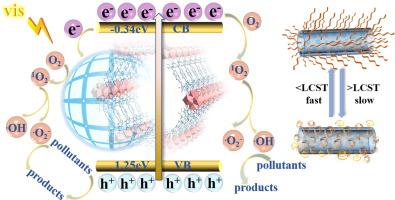Chemical Engineering Journal ( IF 13.3 ) Pub Date : 2021-08-13 , DOI: 10.1016/j.cej.2021.131794 Zhinan Xia 1 , Bingfeng Shi 1 , Wenjing Zhu 1 , Changli Lü 1

|
Zirconium-based porphyrin metal-organic frameworks (MOFs) have attracted extensive attention in the photocatalysis because of their considerable specific surface area, powerful visible light efficiency and semiconductor properties. However, the rapid charge recombination and self-aggregation limit their applications. Here, porphyrin-based Zr-MOF (PCN-222) nanohybrids (CDs@PCN-222@PNIPAM) as an efficient hydrophilic photocatalyst were fabricated by encapsulating various carbon dots (CDs) into PCN-222 nanopores with surface wettability modification by catechol-terminated thermo-responsive PNIPAM having various chain lengths. Due to the electron collecting effect of the nitrogen-doped CDs (N-CDs) and their synergistic effect with PCN-222, the photocatalytic performance of the prepared nano-hybrid photocatalyst were significantly improved. Furthermore, the introduction of hydrophilic polymer with moderate molecular weight effectively enhanced the transfer efficiency of photo-generated charges and the surface wettability of photocatalyst, and improved the water dispersibility of catalyst so that effectively promotes the enrichment and catalytic conversion of water-soluble target pollutants around the active site of the photocatalyst. The removal efficiency of RhB and tetracycline (TC) under visible light irradiation reached almost 100 % and 90.93 % in just 20 min, respectively. In addition, polymer-functionalized Zr-MOF-based nanohybrids revealed an interesting temperature-response switching behavior for the photocatalysis. The study on the catalytic mechanism and degradation pathways of TC showed that the h+ plays a major role in the degradation process, and other reactive species are also involved in the further mineralization of pollutants. This work provides a new insight for the functional modification of MOFs and the design of high efficiency photocatalyst.
中文翻译:

温度响应聚合物系链的 Zr-卟啉 MOF 封装的碳点纳米杂化物具有增强的可见光光降解水中有机污染物的能力
锆基卟啉金属有机骨架(MOFs)由于其相当大的比表面积、强大的可见光效率和半导体特性,在光催化领域引起了广泛关注。然而,快速的电荷复合和自聚集限制了它们的应用。在这里,卟啉基 Zr-MOF(PCN-222)纳米杂化物(CDs@PCN-222@PNIPAM)作为一种高效的亲水光催化剂,通过将各种碳点(CD)封装到 PCN-222 纳米孔中,并通过邻苯二酚-具有各种链长的终止热响应 PNIPAM。由于氮掺杂CDs(N-CDs)的电子收集作用及其与PCN-222的协同作用,所制备的纳米杂化光催化剂的光催化性能得到显着提高。此外,中等分子量亲水性聚合物的引入有效提高了光生电荷的转移效率和光催化剂的表面润湿性,提高了催化剂的水分散性,从而有效促进了周围水溶性目标污染物的富集和催化转化。光催化剂的活性位点。在可见光照射下,RhB 和四环素 (TC) 的去除率在短短 20 分钟内分别达到近 100% 和 90.93%。此外,聚合物官能化的基于 Zr-MOF 的纳米杂化物显示出一种有趣的光催化温度响应转换行为。TC的催化机理和降解途径研究表明,h 提高了催化剂的水分散性,有效促进了光催化剂活性位点周围水溶性目标污染物的富集和催化转化。在可见光照射下,RhB 和四环素 (TC) 的去除率在短短 20 分钟内分别达到近 100% 和 90.93%。此外,聚合物官能化的基于 Zr-MOF 的纳米杂化物显示出一种有趣的光催化温度响应转换行为。TC的催化机理和降解途径研究表明,h 提高了催化剂的水分散性,有效促进了光催化剂活性位点周围水溶性目标污染物的富集和催化转化。在可见光照射下,RhB 和四环素 (TC) 的去除率在短短 20 分钟内分别达到近 100% 和 90.93%。此外,聚合物官能化的基于 Zr-MOF 的纳米杂化物显示出一种有趣的光催化温度响应转换行为。TC的催化机理和降解途径研究表明,h 聚合物官能化的基于 Zr-MOF 的纳米杂化物揭示了光催化的有趣的温度响应转换行为。TC的催化机理和降解途径研究表明,h 聚合物官能化的基于 Zr-MOF 的纳米杂化物揭示了光催化的有趣的温度响应转换行为。TC的催化机理和降解途径研究表明,h+在降解过程中起主要作用,其他活性物质也参与污染物的进一步矿化。这项工作为MOFs的功能修饰和高效光催化剂的设计提供了新的见解。


















































 京公网安备 11010802027423号
京公网安备 11010802027423号